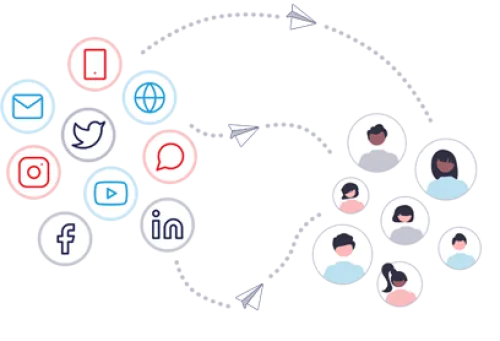Specially in B2B, but also in B2C, email marketing is one of the most effective marketing channels. Still, if you really want to grow data-driven and customer-centric, you will have to look beyond your email marketing software. Putting customers first at any time and for any channel is then a personalized email after an order or inquiry. After all, customers themselves have long been omnichannel.
In the corona years, organizations that previously lagged in online developments have accelerated setting up Web shops and apps and improving digital customer communications. Hybrid models emerged, such as ordering online, picking up in store and receiving the invoice by e-mail. A lot of customer data has been collected. However, this data is often still available in a fragmented form. It's in the webshop, in the CRM, in the app, in the e-mail software, in the till. Multichannel, but not omnichannel.
Wishes and possibilities
Customer communication in single or multichannel marketing is still too often focused on limited data from stand-alone channels with (thus) limited customer insight. Therefore, I often hear the desire and need to be able to aggregate that data and drive channels in an integrated way. However, before you throw yourself (organization) into a large data (warehouse) project or purchase a Customer Data Platform, you do want to know how and which data and channels are going to bring your organization more conversion or efficiency. Before you know it, you are two years and many investments away and not much progress. Not every organization is a 'national', let alone a multinational, that does this on the side. Especially growing organizations with ambition, but not yet the capacity or internal knowledge experience this discrepancy between wishes and possibilities.
What do you have to solve?
With e-mail software you can -in addition to sending your newsletter- already quite well upload lists from different systems and set up automated drip campaigns, but there is more and more work involved with the necessary error proneness and limitations. Not only because customers are using more and more channels interchangeably. Data and segmentation limitations also come into play when you rely too much on one channel. However, the step to a central Customer Data Platform is also very big, and even then you still don't have the assurance that your communication is well managed across all channels.
Let's take a look at what you need to solve as a marketer:
Data integration. Different customer data you want to be able to combine with each other. Transaction data, audience segments, website visits. And preferably in real time. However, that doesn't mean you always need all that customer data 100% integrated. You probably get 80% of your return from 20% data integration.
Channel integration. A customer who appears in a store, you can send a relevant message via text message at that moment. Once that person is searching on the website or in your web shop, you prefer to send a relevant web push message, while at work or at night behind the laptop an e-mail with personalized message reads pleasantly. The actual conversion on all these triggers and channels will have to be proven by testing yourself. After that, you'll want to optimize each channel per customer.
Scalability. 'Dragging' content and data to and from multiple sources and tools is simply not sustainable. Especially if you also want to personalize the message in real time.
The challenge is twofold
How do you avoid a long and expensive IT data project to solve the above issues, half of which turns out to be unnecessary or wrongly set up (for marketing purposes)? How do you first find out on the business side which data, automations and channels will give you the best results?





